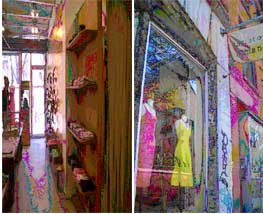Customers
 |
| The Nolita district of New York City is a popular place for young designers to open stores |
The second part of the business plan should answer
- Who will your customers be and how many of them are there?
- How will you market and sell to them?
- Who are your main competitors, if any?
- Why will customers choose your product instead of someone else's?
Another basic question is whether you will be a wholesale or direct to consumer (retail) operation. There are advantages and disadvantages to each.
Wholesale
- You sell only to other businesses, not to consumers.
- You can limit inventory by producing to order.
- You have fewer customers with larger orders.
- Your marketing and distribution efforts will be to fewer customers.
Retail
- You will deal directly with the ultimate buyers of your products.
- You can make a higher profit per unit sold. The wholesale price is typically only half as much as the retail price.
 |

 "[Retail] is not where we're going to start nor is it where we can start, because not enough people know who we are." "[Retail] is not where we're going to start nor is it where we can start, because not enough people know who we are."
Chris Mackin explains the reasons that SweatX chose to sell its products to wholesale instead of retail markets.
|
Another question is how to position your product.
- Will it be a fashion product or a functional product?
- Will you sell it within the fashion industry? Sports industry? Corporate sales industry?
- Will you sell it in department stores, specialty shops, boutiques?
- Will you sell it on the Internet? Through your own site, on exchanges, auction sites?
The product development and life cycle modules will discuss these questions in greater depth and recommend resources to conduct product and market research as you develop your business plan.
 |

 "I would wear everything that I created and sewed and people would ask me, where did you get that?. This was my great informal focus research." "I would wear everything that I created and sewed and people would ask me, where did you get that?. This was my great informal focus research."
Kathleen Saxby shares some advice for prospective apparel start-up businesses, including some ideas for distinguishing her designs using design details as the surprises that draw customers.
|
|

1. Why should you write a business plan?
2. What are the three Cs of a business plan?
3. What is the core competency and value proposition of your business idea?
|
|



